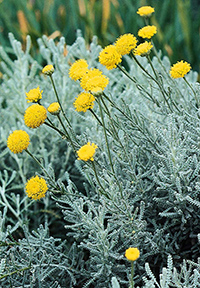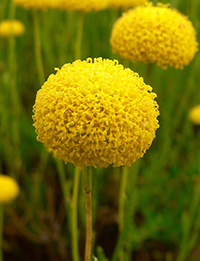Table of Contents
Lavender cotton not only loves the Mediterranean sunny climate, but it is also a promising substance for preserving clothes; since putting its flower bouquets into the wardrobe, it repels moths and other insects.

Lavender Cotton Scientific Facts
- Other names: Ground-cypress.
- French: Santoline.
- Spanish: Abrotano hembra.
- Environment: Plant native to the Mediterranean countries, where it grows in rocky calcareous soils. It is also cultivated in gardens.
- Description: Vivacious plant of the Compositae family, growing from 20 to 50 cm high, with hairy, finely divided leaves resembling those of cypress. Its flowers are golden yellow, growing in terminal heads, with a strong aroma and sour flavor.
- Parts of the plant used medicinally: The seeds and the flower heads.
Healing Properties and Indications

The whole plant, especially its flower heads, contains up to 1 percent of the essence, composed of a ketone (santolinone) and a phenolic ester. Other components are tannin, resin, and a bitter component. Its properties are similar to those of the camomile plant.
- Stomachic tonic, digestive, and antispasmodic: This is an ideal plant to ease digestion for those people suffering from stomach disorders.
- Vermifuge: Very useful against intestinal parasites, which children usually have, such as Oxyuridae and ascarides.
- Mild emmenagogue: It produces menstruation.
- When externally applied in the bathwater, lavender cotton produces a pleasant emollient effect (reduces skin inflammation) and has relaxing and soothing properties.
How to use Lavender Cotton

As a digestive and emmenagogue substance:
- Infusion with six or seven flower heads per cup of water. Drink a cup after each meal.
- Essence: The recommended dose is 3-5 drops, three times a day.
As a vermifuge:
- Infusion with a teaspoonful of seeds per cup of water. Drink a cup every morning for a week. After one month, repeat the intakes.
- Seeds powder: 2-4g, mixed with honey or fruit juice.
- Hot baths: Pour two liters of infusion into the bathtub, made with a big handful of flower heads or 10-20 drops of the essence.
Frequently Asked Question
Does this plant have similar stress-reducing properties to true lavender?
While lavender cotton shares a similar scent profile with true lavender (Lavandula), its stress and anxiety reduction effects aren’t as well-established. Traditional lavender has more research backing its use in aromatherapy for relaxation.
Can it be used for sleep problems?
There’s limited scientific evidence directly supporting lavender cotton for sleep issues. However, its potential calming scent, like traditional lavender, may offer some anecdotal benefit for those who find it relaxing.
Is lavender cotton safe for topical use?
Care should be taken with topical use. Lavender cotton essential oil can cause skin irritation in some individuals. Do a patch test and dilute it with a carrier oil before applying it topically.
Are there any digestive benefits to lavender cotton?
Lavender cotton has been used as a folk remedy for digestive upset. While there’s limited scientific research on this, some of its compounds may have mild antispasmodic effects, potentially helping with stomach cramps.
Can lavender cotton help with wound healing?
The plant may have antimicrobial and anti-inflammatory properties. This could theoretically aid wound healing.
Does lavender cotton interact with any medications?
It’s always best to consult your doctor before using lavender cotton, especially if you take medications. There’s potential for interactions, particularly with drugs that have sedative effects.
Are there different ways to use lavender cotton for health purposes?
Yes! Here are some standard methods:
Aromatherapy: Diffuse the essential oil or use dried plant material in sachets.
Herbal Tea: Infusions can be made from the leaves and flowers (consult an herbalist for safe dosage).
Topical Application: Always dilute essential oil and use it with caution.
Is lavender cotton safe for everyone?
Generally, lavender cotton is considered safe for most adults in moderation. However, due to insufficient safety data, pregnant and breastfeeding women and young children should likely avoid its use.
Where can I find reliable information on lavender cotton?
Here are some sources to consider:
PubMed: https://pubmed.ncbi.nlm.nih.gov/ Search for scientific studies on “Santolina chamaecyparissus”
Herb Research Databases: Consult reputable databases like those from universities or botanical organizations.
Professional Herbalists: Seek advice from a qualified herbalist for personalized recommendations.
Is lavender cotton a replacement for conventional medicine?
Definitely not! While lavender cotton may provide further support, it is not a replacement for professional medical advice or care.
DISCLAIMER: All content on this website is presented solely for educational and informational objectives. It would be best to not rely on the information provided as a replacement for advice, diagnosis, or treatment from a qualified medical expert. If you are pregnant, nursing, or have any preexisting medical concerns, you should talk to your doctor before using any herbal or natural medicines.
REFERENCES
George D. Pamplona-Roger, M.D. “Encyclopedia of Medicinal Plants.” George D. Pamplona-Roger, M.D. Encyclopedia of Medicinal Plants. Ed. Francesc X. Gelabert. vols. 2 San Fernando de Henares: Editorial Safeliz, 2000. 470. Print.
